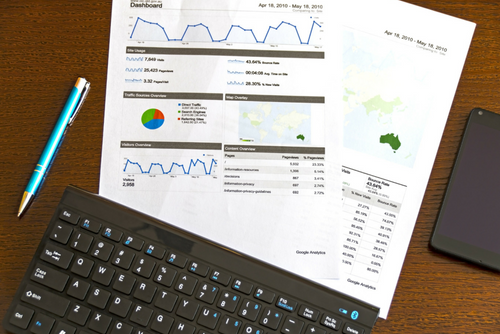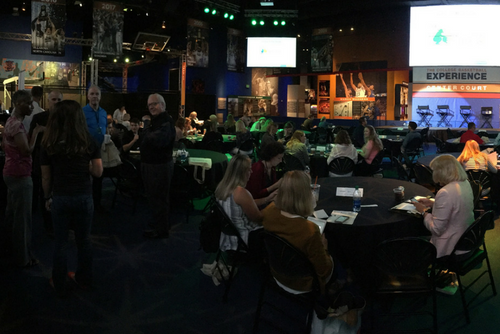As we return to in-person events, you might be feeling a little overwhelmed, and maybe even a bit rusty when it comes to your event marketing strategy. Like most companies, you’ve probably seen a decrease in your inbound lead volume due to the pandemic and are wondering how to get the most out of upcoming tradeshows and other events. Adding digital marketing to your traditional tradeshow marketing channels can help you expand your reach at your next event and find new prospects within your target markets. The below guide is designed to show you when and where to layer in digital marketing to make the most of your tradeshow investment.
20 Weeks from the Event
Realistically, you can start marketing for your upcoming event as soon as it is officially announced, but we generally recommend you hold off until five or so months before the big day. This is to avoid inundating your target audience with information that is not exactly timely, and consequently not relevant to them yet. Once you do find yourself within this six-month pre-event period, your marketing focus should be split evenly between search engine optimization, content creation and owned media utilization, depending on your specific strengths as an organization.
Search Engine Optimization (SEO)
Your SEO efforts related to the event can be as simple, or as complicated, as you want. The most important thing is that you are engaging in some sort of search engine optimization, as ignoring this marketing avenue can result in you missing out on an opportunity to get your brand in front of hundreds, or even thousands, of individuals who otherwise may not even know your company is attending the tradeshow—think of all the potential leads you could be missing out on here!
One of the easiest ways to tap into this organic traffic is by creating a dedicated landing page on your domain where you gather relevant content for your event audience. If you already have an /events URL path on your site, go ahead and throw this landing page in there (i.e., www.YourDomain.com/events/EventName). If not, just use the most logical location, likely wherever you’ve placed information about upcoming events in the past. Regardless of where this landing page lives on your site, you’ll want to be sure to link to it from your home page, perhaps as a new item in a preexisting news carousel or in your navigation bar.
Once you’ve decided where this landing page is going to live on your site, there are a few things we recommend you do in order to most effectively optimize this page for both users and search engines:
- Make the name of the event the title of the page. Be sure to indicate to search engines that this is the most important heading on the page by using the H1 html heading tag.
- Immediately after the title, include the date, time, and location of the tradeshow, as well as a link to the actual event website.
- After you’ve done this you can insert some general information about the event and a breakdown of your company’s distinct role in the event: speaking sessions you’ll host, events you’re planning onsite and what attendees can expect if they come to your booth.
- You will want to link to any blog posts related to the upcoming tradeshow and/or its subject matter from this page. If applicable, include a link to a relevant piece of downloadable content.
- Finally, we recommend you include some sort of call to action on this page so that you can start identifying sales qualified leads early on—usually this looks something like a contact form encouraging attendees to schedule a specific time to meet with your team during the show or requesting specific information while at the event.
It’s really that easy and it really works! We have actually seen multiple clients outrank the dedicated event website in the search engine results page purely by completing the steps listed above.
Content Creation
This piece of your long-term tradeshow marketing strategy is pretty closely related to your SEO efforts, but instead of creating a dedicated landing page, this component involves putting together blogs, whitepapers, graphics and the like in order to capture more organic traffic and support the aforementioned landing page. Some examples of content that have proven to be effective for our clients in the past are:
- Create a blog announcing your participation in this year’s tradeshow; be sure to spread it through your social channels!
- If you or someone else from your organization will be speaking at the tradeshow, consider writing a whitepaper directly related to the topic they will be speaking on.
- Create dedicated graphics for social media and post on your social channels letting attendees know why they should visit your booth (don’t forget to use the tradeshow hashtag!)
Owned Media
The owned media element of your long-term event marketing strategy is probably the most straight forward of the three. It involves leveraging your existing digital marketing channels in an attempt to capture the attention of individuals who are already familiar with your brand. There are a few ways you can do this, one of the easiest being to take advantage of your existing social channels, e.g., Twitter, LinkedIn, Facebook, Instagram, YouTube, etc. Post about your involvement in the upcoming event, post links to the new content you produce related to the event, and repost material from the tradeshow’s official channels. Look for material that will help garner the attention of your followers and solidify the relationship between your brand and the show. You should also be leveraging your social channels to encourage registration/attendance to the event. It is in your best interest to drive event registration.
Another way to utilize your owned media channels is through email. This is especially true if your organization has attended this specific tradeshow before, as you can make good use of any prospect lists you have from previous years by sending an email with links to the landing page and information on how and where they can find you at the event.
Five Weeks from the Event
As the date of the tradeshow creeps closer and your organic marketing efforts have a chance to pick up some steam, you’ll want to pivot to a strategy that leans more heavily on paid search and paid social, with some programmatic advertising and email thrown in for good measure. Usually, we recommend making this transition about four or five weeks from the event kickoff.
Paid Search
Paid search campaigns are a tried and true digital advertising method that you can easily implement to support your brand in relation to the upcoming event. We suggest optimizing your ad copy to target the name of the event, for example: “And Then Some Conference,” and “And Then Some Conference 2021,” in addition to general industry terms like “marketing tradeshow” and “email marketing conference.” Depending on your budget, you can also focus on more specific terms associated with the tradeshow and your brand. In keeping with the previous example, this would include phrases like “emfluence conference” or “emfluence conference 2021.”
Another way to segment search campaigns is through geotargeting, which is the practice of delivering advertisements to potential attendees based on their geographic location. If you decide to go this route, you will want to target people in or who have shown interest in the location of the tradeshow. This targeting can be as broad as the city or metropolitan area of the event, e.g., Kansas City, or as precise as the actual event space itself, although at this point in your marketing timeline we recommend just sticking with the city.
Paid Social
Much like the way you can utilize your social media channels to support your organic tradeshow marketing, you can also use them to support your paid marketing efforts. In fact, many social media sites have a built-in paid component similar to Google Ads. In our experience, the most effective of these paid social programs can be found on LinkedIn, Twitter and Facebook. Each site has different requirements in order to begin a campaign and different ways you can choose to segment your audience targeting. For both Facebook and LinkedIn, you will need a list of job titles and prospective companies you want to focus on. For Twitter, you can generally get away with a list of individuals who follow the tradeshow account, although for all three sites a list of attendees’ emails is definitely the preferred means of segmentation.
Owned Media
Ensure you have an ongoing, consistent messaging strategy across all appropriate social media channels to promote your participation in the event. Think about creative ways to promote the event and your participation. Feature any presenters you may have at the event. Or if you are planning a giveaway or a new product release, make sure you tease that to encourage more engagement.
Programmatic Advertising
As a supplement to your paid search and social advertising, you’ll likely want to do some programmatic advertising. For those not yet initiated into the wonderful world of programmatic, it is essentially the same as the display advertising you are probably used to, except that it cuts out the majority of the optimization guesswork and purchasing legwork. By simplifying these two aspects of digital advertising, you spend less time and effort getting your ads in front of the right audience, which in turn results in a better return on investment for your campaigns. We recommend you target your programmatic ads to individuals who visited last year’s tradeshow site (usually a convention center) during last year’s tradeshow dates.
Remember the email blast you sent a few months ago letting your prospects from previous years know about this year’s event? Shortly afterward, you hopefully saw a nice bump in traffic to your tradeshow landing page and consequently an increase in leads through your on-page contact form. Well, now it’s time to pull that email list out one more time and send an event reminder! Be sure to include all the information attendees may need, like the event schedule, parking information, catering information, etc. If you have a discount registration code from the tradeshow organizers, be sure to include it here too.
The Week of the Event
After letting your paid advertising run its course for about a month, the tradeshow date has finally arrived and it’s time to change up your marketing strategy once again, but not too drastically. This time you’ll still be focusing a fair amount on paid social, paid search and programmatic, but email and organic social are really going to take the reins.
Paid Search and Programmatic Advertising
Your paid search and programmatic advertising strategy will remain essentially the same as it’s been over the last month. You’ll want to continue to geotarget the city where the event is taking place, but now you will also want to start targeting the actual event space itself and any known hotels and popular locations around the venue.
Paid Social
At this point, you should have access to an accurate list of those who have RSVPed to attend the tradeshow, which presents you with a fantastic foundation to build highly targeted paid social campaigns on. Make use of this list and start running campaigns to these people, switching up your call to action to be something along the lines of “Come See Us,” or “Visit Our Booth.”
Organic Social
Perhaps the best way to boost engagement and capture leads once the tradeshow begins is through organic social engagement, something you were likely planning on doing already if you’ve attended an event like this in the past. Some easy and engaging ways to do this are:
- Post the daily schedule and reminders about upcoming sessions and giveaways on your social channels.
- Create a hashtag on Twitter that is specific to your brand in relation to the tradeshow and encourage attendees to live tweet and use this hashtag during demos, speaker presentations, and other various events you run at the conference. Try to encourage the use of the tradeshow’s specific hashtag when it makes sense; if the tradeshow itself starts trending, that’s good for every company in attendance, including your own!
- Take lots of photos! Mark them with your hashtag or put together a gallery on your site after the event— just be sure to remind attendees that they will need to follow your social media accounts or sign up for your email list to find these photos later.
- If you are savvy with video, you may want to consider putting together a recap video that you can post after the tradeshow. Encourage attendees to follow your social media accounts or sign up for your email list so that they are notified when this video is published.
- Encourage attendees to connect with you or your brand on LinkedIn (this will prove to be useful when next year’s tradeshow rolls around).
Your email strategy during the tradeshow is going to look very similar to your organic social strategy. In that you’ll want to email out the schedule and reminders about upcoming speaking sessions, demos and the like to those who have opted in for these notifications in prior email communications. Aside from that, your other focus in regard to email should be growing your subscriber list. Create a landing page for event giveaways that encourages contacts to sign up for your newsletters as they register for the giveaway.
After the Event
After months of preparation and hours upon hours of hard work, the tradeshow is over. Don’t get too comfortable yet, though—your work isn’t quite finished! You should now have several lists as a result of your participation in the event:
- People who registered for giveaways.
- People who were captured via lead scanners.
- People who gave your sales team business cards.
The worst thing you could do here is throw all of these lists together in the same email nurture while patting yourself on the back saying, “job well done.” You need to make sure you treat these lists with care and segment each list based on whether the leads they contain are sales qualified or marketing qualified.
For all leads, both marketing and sales qualified, send a series of emails with links to resources you were sharing at your booth, ways to sign up for newsletters, registration links to a relevant webinar, and ways to get in touch with someone to answer any sales questions they may have. For sales-qualified leads, create an email nurture that looks like it’s coming from a member of your sales team and begin running a post-tradeshow campaign.
Also plan to create a post event blog post or event recap to highlight the event. Be sure to share any specific content you had created for the event (i.e, post your presentations to slideshare and promote those). If you had special giveaways, give a shoutout to the winners on social media or other channels, as appropriate. Your blog post recap could be a “lessons learned from this year’s event.”
After an appropriate amount of time, shift your event landing page to a promotional page for the next year’s event and archive your previous content. This will allow you to build ongoing credibility for your event landing page.
Include this new list in your ongoing promoted social and/or display ads—bonus points if those ads are targeted to this unique audience!
Ready to get started? Download our Tradeshow Marketing Checklist!



